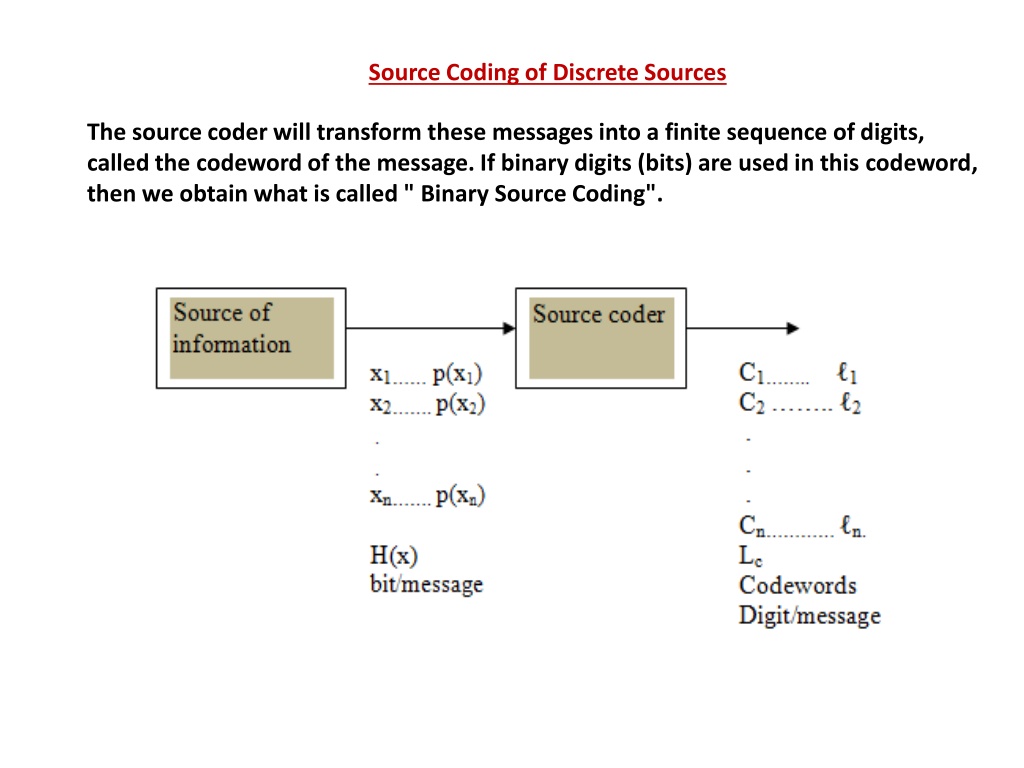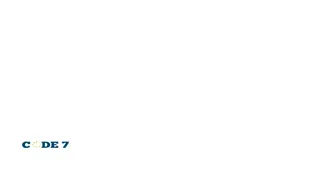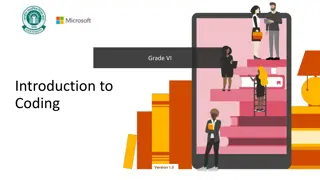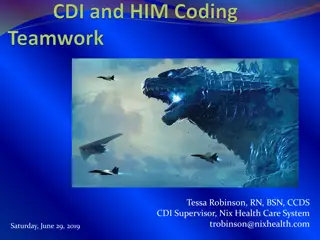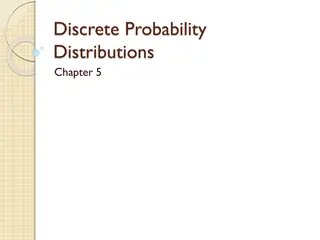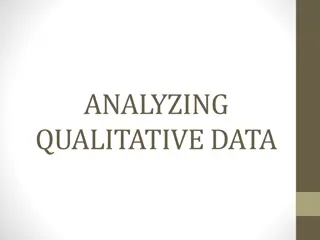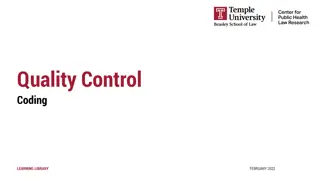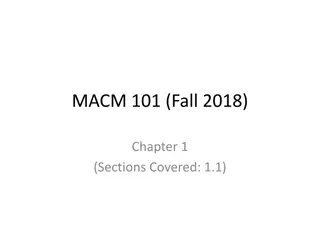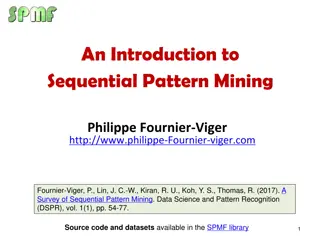Understanding Source Coding for Discrete Sources
Source coding involves transforming messages into codewords, with considerations for minimizing code length and ensuring unique decodability. Binary source coding and efficiency are key concepts explored in this process. Check out the details and examples provided to deepen your understanding of source coding principles.
Download Presentation

Please find below an Image/Link to download the presentation.
The content on the website is provided AS IS for your information and personal use only. It may not be sold, licensed, or shared on other websites without obtaining consent from the author. Download presentation by click this link. If you encounter any issues during the download, it is possible that the publisher has removed the file from their server.
E N D
Presentation Transcript
Source Coding of Discrete Sources The source coder will transform these messages into a finite sequence of digits, called the codeword of the message. If binary digits (bits) are used in this codeword, then we obtain what is called " Binary Source Coding".
The selection of codewords for different messages xi, is done according to the following two considerations: 1- The average code length Lc must be as minimum as possible. This average length is given by: = i i i c p L 1 n = = ( ) x digits/message i Where li is the length of the codeword for message xi (li is in bits for binary coding, or in digits for nonbinary coding). 2- The codewords at the receiver must be uniquely decodable. Uniquely decodable means that any codeword for any symbol( or message) must not be the beginning from the left for any other codeword of higher length.
Ex: The code table for a certain binary code is given as: [1]-Find the average code length, then comment. =0.2+2*0.1+3*0.4+3*0.3=2.5bits/message [2]-If the received data stream is 1 0 1 1 0 0 0 1 1 1 1 1 0 .., check if this code is uniquely decodable or not, then comment. using the given code table, then: 1 0 | 1 1 0 | 0 | 0 | 1 1 1 | 1 1 0 | .., x2 | x3 | x1| x1| x4 | x3 | ., Hence the code is uniquely decodable, since the receiver get at only one possible message stream.
the code is not optimum in terms of Lc, This gives Lc=0.4+0.3*2+0.2*3+0.1*3=1.9 bits/message which is less than before. Ex: Checkif the following code is uniquely decodable or not: This code is not uniquely decodable since ''10'' is a codeword for x2 , while the codeword for x3 starts with ''10''.
Coding efficiency and redundancy: A code with average code length Lc digits has coding efficiency: where: ( ) H log x = L D 2 c H(x) is source entropy in bits/message, Lc is average code length in digits/message Lc has the units of the code size, ( i.e. If D=2 bits/message , if D=3 ternary digits/message and so on ..). log2(D) in bits/digits D=coding size ( D=2 for binary coding, D=3 for ternary coding, and so on .). X H ( = ) For binary coding only (D=2), then: c L The code redundancy is simply R=1- . suppose the source produces M messages, then the amount of information produced at the source output will be M*H(X) bits, while the amount of information at source encoder output is M*Lc digits or M*Lc*log2(D) bits, so the ratio * ( ) ( ) M H X H * X = * log log M L D L D 2 2 c c
Source Codes 1]Fixed Length Codes 2]Variable Length Codes a)- Shannon Code b)- Shannon Fano Code c)- Huffman Code
1] Fixed length Codes: This is used when the source produces almost equiprobable messages, p(x1) p(x2) .. p(xn), . This Lc is given for D-sized code by: 1- Lc = logD(n) if n=Dr (r is an integer) (n is the number of messages) 2- Lc= Int[logD(n)]+1 if n Dr . (Int=integer part) For binary coding , then: 1-Lc=log2(n)=H(X)|max bits/message if n=2,4,8,16, .which gives =100% . 2- L c=Int[log2(n)]+1 if n 2r which gives less .
Ex. A discrete source has an alphabet of five equiprobable letters. Evaluate the efficiency of a fixed length binary code. Sol:/ n=5 2r (binary D=2) Lc= Int[logD(n)]+1 = int[log2(5)]+1 = 3bits/letter H(X)=log2(n)= log2(5)= 2.32 bits/letter xi x1 x2 x3 x4 p(xi) 0.2 Codeword Ci 000 0.2 001 =H(X)/Lc= 2.32/3 = 77.3 % 0.2 010 0.2 011 x5 0.2 100
Ex: Find the efficiency of a fixed length binary code used to encode messages obtained from throwing (a) one fair die . (b) two fair dice. (c) 3 three fair dice. (a) n=6, possible equiprobable outputs when throwing one fair die, hence: Lc= Int[log2(6)]+1=3 bits/message =H(X)/Lc=log2(6)/3=86.1% (b)For two dice, then n=6*6=36 equiprobable, hence: : Lc= Int[log2(36)]+1=6 bits/message =6 bits/(2-symbols)=3bits/symbol [note that each message consists of 2 symbols]. While H(X)=log2(6)= bits/symbol, then: =H(X)/Lc= log2(6)/3 = 86.1% (c) For three dice, then n= 6*6*6=216 and : : Lc= Int[log2(216)]+1=8 bits/message =8 bits/(3-symbols) =(8/3) bit/symbol [each message consists of 3 symbols], then: =H(X)/Lc= log2(6)/(8/3) = 96.9% HW: repeat previous example for ternary fixed length code. Hint ; D=3; Lc = log3(n) if n=3r Or Lc= Int[log3(n)]+1 if n 3r ( ) H log x = L D 2 c
2]Variable Length Codes (minimum redundancy codes ): When message probabilities are not equal, then we use variable length codes. Three types of these codes are given: a)- Shannon Code: For messages x1, x2, x3, .,xn with prob. p(x1), p(x2), p(x3) p(xn), then for binary coding (D=2): Step 1: Arrange the messages in a decreasing order of probabilities, Step 2: Find the codeword length li such that: 1- li = -log2 p(xi) if p(xi) = ( )r = , , , 2-li = Int[-log2 p(xi)]+1 if p(xi) ( )r 1 i Step 3: Find wi = k = ( ) w p x i k 1 1 > wi 0. Step 4: Find the codeword ?? by multiplying wi by D and take the integer part until li times multiplication
Ex: Develop binary Shannon code for the following set of messages: x1 x2 x3 x4 x5 x6 p(X) = [ 0.2 0.4 0.15 0.1 0.06 0.09] then find: [a] coding efficiency and redundancy. [b]p(0) and p(1) at encoder output. [c]amount of information produced at encoder output if the source produces 1000 message. sol:/ 1) arrange the message in decreasing order of probability: p(X) = [ 0.4 0.2 0.15 0.1 0.09 0.06] 2) Find the codeword length li li=Int[-log2 0.4]+1=2 bits, l2= Int[-log2 0.2]+1=2 = 3 bits, l3= Int[-log2 0.15]+1=3 bits, l4=4 bits , l5= 4bits , l6 =5bits. 3) To find wi : W1 =0 W2 = w1 + p(x1) = 0+0.4=0.4 W3 =W2 + p(x2) = p(x1) + p(x2) =0.4+0.2=0.6 W4 = 0.6+0.15=0.75 W5 = 0.75+0.1=0.85 W6 =0.85+0.09=0.94
4) To find codeword ??: multiply Wi by D for li times:- ?1 = W1 x 2= 0 x 2=0 0 x 2=0 ?1 =00 = W2 X 2= 0.4 X2= 0.8 ?2 0.8X2=1.6 0.6X2=1.2 ?2 =011 ?3 0.2X2=0.4 0.4X2=0.8 ?3= 100 = 0.6? 2 = 1.2 ?4 =1100 , ?5 = 1101 , ?6 =11110 Note that the two considerations are fulfilled ( less Li for higher p(xi) and the code satisfies the uniquely decodable condition). xi x1 x2 x3 x4 x5 x6 p(xi) 0.4 0.2 0.15 0.1 0.09 0.06 Li 2 3 3 4 4 5 wi 0 0.4 0.6 0.75 0.85 0.94 Ci 00 011 100 1100 1101 11110 0i 2 1 2 2 1 1
xi x1 x2 x3 x4 x5 x6 p(xi) 0.4 0.2 0.15 0.1 0.09 0.06 Li 2 3 3 4 4 5 wi 0 0.4 0.6 0.75 0.85 0.94 Ci 00 011 100 1100 1101 11110 0i 2 1 2 2 1 1 a)-To find code efficiency then H(X)= 2.29 bits/message, and: Lc= 2x 0.4+3x 0.2+3x 0.15+ = 2.91bits/ message Then: =H(X)/Lc= 2.29/2.91= 78.6% Thenp(0) = 2? 0.4+1? 0.2+2? 0.15+2? 0.1+0.09+0.06 P(1)= 1- p(0)= 0.46 = 0.56 2.91 c) The rate of information= rate of message produced x Lc x log2(D) = 1000x 2.91x 1=2910bits/sec
b) Shannon-Fano Code ( Fano Code): The procedure for binary Fano code is given as follows: Step 1: arrange the messages in a decreasing order of prob. Step 2: find out a point in the decreasing order such that the sum of probabilities upward is almost equal to the sum of prob downward. Step 3: assign all messages upward as ''0'' and all messages downward as ''1''. Step 4: repeat steps 2 & 3 many times on the upward and downward parts until all the messages are separated Ex: Develop Fano code for the following set of messages: x1 x2 x3 x4 x5 p(X) = [ 0.25 0.4 0.1 0.15 0.1]
